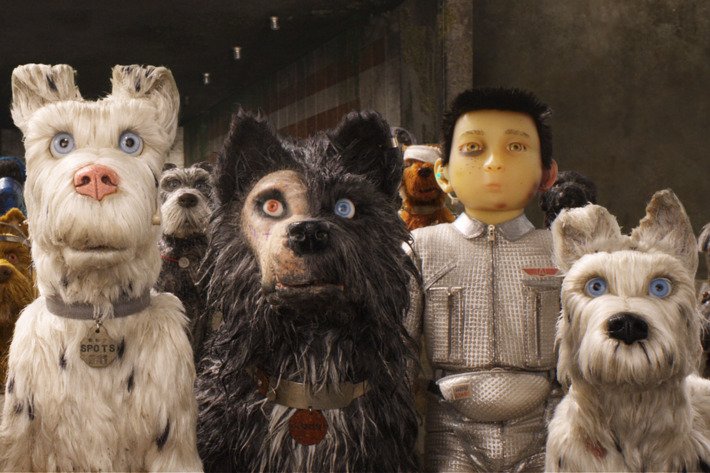Wes Anderson films may look chaotic, seemingly unimproved, like a derailing derailleur train. This train, however, moves with its own logic, mission. Perhaps, in order to take their neurotic passengers to a renewed world in which they will see something they have not seen and will understand something for themselves that they did not know. Someone has said that man is a man when he travels. I think this is true for Wes Anderson's films. He draws cards for his characters and turns their journey into a means of personal rediscovery. Transformation is always a topic that is approached with curiosity and seriousness. Andersen's man is a swirling issue, which he is accustomed to in his response. Maybe this answer is not universal or unique, but it finally works ... somehow. All of this is provided with a magnificent imagination, a totally distinctive artistic handwriting, a lot of romance, nostalgia and a wealth of mutual relationships. And it may sound like a cliche, but in this cliché lies the key - the director is a genre in itself.

"Isle of Dogs" takes us to the fictional town of Megasaki, where a dog virus has spread in the near future. The epidemic has become a media and political phenomenon. Did the dogs, man's best friend, suddenly turn out to be his greatest enemy? The tyrannical ruler of the city, Mayor Kobayashi (Kunici Nomura), loves cats (like any black-and-white brute, hates dogs), orders all barking four-legged animals to be extradited to the hunk of the garbage island whose atmosphere and aesthetics are completely in the spirit of his name. The first animal to be picked up and placed in its locked cage in the dump is Spotts (Liev Shriber), Pet's pet and child bodyguard Atari Kobayashi (Coyu Rankin), the nephew of the mayor. Atari, however, has nothing to do with his uncle - he loves dogs and is attached to Spots. And he's got to figure it out, whatever it costs. This is the adventure, the journey - a story of rescue, care and love that are more inspirational than any malice. Roger Ebert also points out that Anderson skillfully captures the Japanese mono no aware. The term literally means "empathy for things", a state in which one observes the beauty of the universe, the nature and the events around him, while taking into account their efficacy. Already existing, things keep within themselves the shades of their coming sunset. In Anderson's films, this is projected into the all-pervasive nostalgia, imposed as a mask on his main characters. They are often people who are burdened with their knowledge of the world. They do not complain, their sadness is not loud, but it is in them and beyond. Their sadness will not disappear, even if they take escape from her. It will always be at your fingertips to hug them if there is no one else.
The film has been made for years. The genre of stop motion animation implies a lot of zeal, purposefulness and perfectionist tuning to the details. Some of the dolls have duplicates in different sizes, depending on what type of footage they're taking - for example, if the shot is shot, the doll should be far greater to stand out among the large décor that surrounds her. The pictures themselves are also labor intensive and stretchable. Jason Shuorzman, for example, who regularly works with Anderson (here as a co-writer, along with Roman Coppola and Kunici Nomura) tells during a Q & A session that there was a day when they only worked on an excerpt of about 2 seconds in which the Spots dog looks up. For Wes Anderson, it seems superhuman embarrassment and patience is a superpower - I can hardly imagine introducing it, for example, to those ships in the glass bottles (called impossible bottle and absolutely stunning!). Man truly dwells in the worlds that create and work on their full-blown uniqueness. The best thing about all this is that he has found a sufficiently serious and talented team of people who not only enthusiastically share his vision, but work with him for years. If you are wondering how worlds are being built, they have deep roots in the minds and imaginations of people - so - with work and perseverance.

"Isle of Dogs" is not a cynical film. No Wes Anderson's movie is. Although his characters are often gloomy (such as Chief, sounded brilliantly by Brian Cranston), heroes who have tasted the bitterness of the world (and have never tried phenomenal canine cookies), they are sad, precisely because they are romantics. The clash between the world as it wishes to be, and as it is, triggers in them the mechanism of compensatory aggression, the seemingly rejection of reality. However, they always show the sleeping tenderness that they are not only capable of, but for which they long for. They only have to find followers, if only they can love and be loved. This is the transformation that happens here exactly to the Chief Dog (which even from black becomes white, after an abundant wash by Atari). It is the closeness that is the confirming theme of the film, the succession, not the division. And this is a powerful and beautiful idea in which we could listen.
You got a 10.47% upvote from @postpromoter courtesy of @godflesh!
Want to promote your posts too? Check out the Steem Bot Tracker website for more info. If you would like to support the development of @postpromoter and the bot tracker please vote for @yabapmatt for witness!
"Neurotic passengers" for sure! Count me among them; I also enjoyed the film.